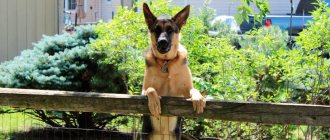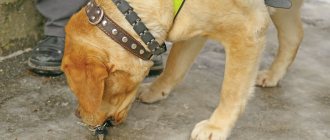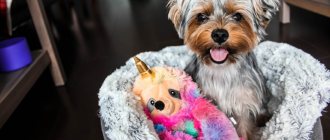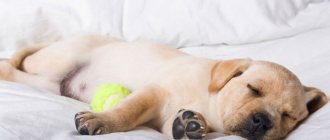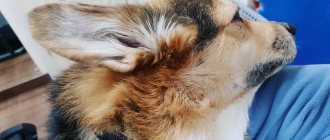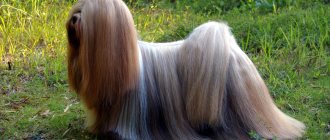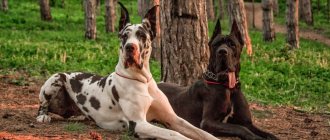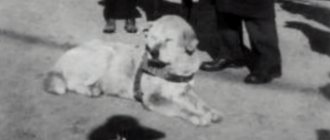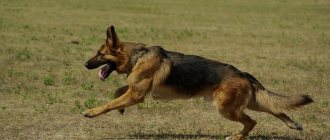History of the origin of the breed
The Komondor breed was originally brought to Hungary from the territory adjacent to the Black Sea. Over time, the true origin was forgotten, only a beautiful legend and a scientific version remained.
Legend
Dogs with wool dreadlocks are the fruit of love between a lion and a sheep. The story took place more than 1000 years ago, the king of beasts fell in love with a meek lamb. Tender and timid, with snow-white fur, she captivated the heart of a formidable predator. The sheep reciprocated the love of the lion; the most unusual wedding in the history of the animal world took place. After the allotted time, the cubs were born, covered with snow-white fur, like their mother’s, and with their father’s character.
Scientific version
The historical account of the appearance of the Hungarian Shepherd Dog, called the Komondor, is more boring than the tale of the love of a lion and a sheep.
As written above, the breed is very ancient, more than 1000 years old. Its history began in territories located on the Black Sea coast. Previously, they were inhabited by peace-loving tribes, but during the Tatar-Mongol invasion, they were evicted to the Hungarian plateaus. After leaving their homes, people took their dogs with them. In the new territories we had to adapt; there was a need for universal dogs that could herd and protect livestock, as well as the owners themselves. The huge Komondors coped with the task assigned to them with dignity.
The breed was formed under the influence of the local climate; for many centuries people did not participate in its selection. As a result of natural selection, large, shaggy and ferocious dogs were obtained, capable of standing up for their master and the entrusted livestock.
Despite their extensive history, animals received official recognition only at the beginning of the 20th century. In the 1900s, several representatives were brought to the United States, and Komondors conquered local dog breeders. Work began on its active breeding; the peak of the Hungarian Shepherd's popularity occurred in the first half of the last century.
After the war, the Komondor dog breed was on the verge of extinction. Hungarian dog handlers and enthusiasts did not want to lose their national pride, and work began on its restoration. Now the breed has been completely restored, is widespread throughout the world and is loved among true dog connoisseurs.
Choosing a puppy
Throughout the world, the Komondor remains a very rare breed. In Russia, their breeding began in the 90s and today the livestock numbers about 500 dogs. Which are united by the national Komondor breed club.
It is always better to look for a baby through a breed club, where all representatives of the breed, planned matings, litters and puppies are registered.
If you need a top-class puppy, you will have to seek help from an experienced dog handler or breeder. If you love a dog, you can choose a Komondor puppy yourself. First of all, you need to read the standard and when choosing a puppy, pay attention to its compliance with the requirements. Of course, at 2 months he vaguely resembles that powerful, strong dog that the document describes, but some aspects are already visible to the naked eye. The nose and lips should be black, the bite is correct, the eyes are almond-shaped, dark, the claws and pads are dark gray or black, the tail is long, not curved, without creases, the color is only white, the coat is wavy and soft. Komondor puppies are born weighing about 0.5 kg. By two months they already weigh 7-8 kg, and by three months - 10-14 kg.
It is worth noting that the order at birth and the size of the dog at the time of selection do not in any way affect further physical and mental characteristics. The main thing is that the puppy is healthy, strong, moderately well-fed and active. The presence of the guard instinct is tested by throwing an object unfamiliar to the puppies on the floor. An alert, brave baby will immediately become interested and run up, perhaps starting to bark. This and other tests are very conditional, because the character is formed not only by congenital data, but also by the conditions in which the puppy will grow and develop.
Komondor puppy price
The Komondor is expensive, but in addition, owners will face considerable maintenance costs in the future: care, good nutrition, veterinary care. A puppy from titled parents costs on average 45-50 thousand rubles. Puppies without documents are very rare, but even their price rarely drops below 15-20 thousand rubles.
Description of the breed with photos
The Hungarian Shepherd dog breed standard, according to the FCI, looks like this:
- General appearance: large, harmoniously built dog with a mistrustful character.
- The head is wide and large, with a convex skull and well-developed brow ridges.
- The muzzle is medium, the transition from the forehead to it is very pronounced.
- The eyes are almond-shaped, deep-set, and always dark brown in color. Light shades are undesirable; blue-eyed dogs are considered a breed defect.
- The nose is large, with wide nostrils. The nose is always black; other shades are considered undesirable.
- The jaws are strong and well developed, the lips fit tightly to the teeth, and are black in color.
- The ears are medium set, hanging from the base in the form of an elongated letter “U”.
- The neck is of medium length.
- The body is elongated.
- The back is wide, short and level.
- The loin is muscular and wide.
- The chest is deep, with highly developed transverse muscles.
- The limbs are straight and muscular.
- The tail is set low, reaches the hock joint, and is slightly curved at the end.
Size and weight
The Hungarian Shepherd Dog or Komondor has gigantic dimensions.
| Gender of the dog | Height (cm) | Weight, kg) |
| Male | 70-85 | 50-60 |
| Bitch | 65-72 | 40-50 |
Color and coat type
The only acceptable color is white.
The coat is hard and consists of numerous cords. Their greatest length on the croup and hips is from 20 to 27 cm. The shortest hair is on the lips and paws, it is 9-11 cm.
Note! The breed standard does not provide for any color other than white.
Dogs with dreadlocks, cords and plates - they don't need a groomer
Category: Choosing a dog, News about dogs
Dogs with dreadlocks, cords and plates. The hairdresser will not help these breeds . Commander, Puli, Bergamasco - when you see an adult dog of the listed breeds, you will immediately think of the hairdresser - “maybe it needs a haircut.”
The coat is what makes these dogs look very exotic. Dogs' fur is gathered into separate cords called dreadlocks. The structure is very unusual - it consists of a long, wavy, coarse outer hair and a short, soft, dense undercoat. It is the combination of these two types of pile that forms the cord. Moreover, the ratio of the amount of awn and undercoat determines the quality and structure of the cord.
These dogs look like young men with African braids and dreadlocks. But boys and girls deliberately do such hairstyles for themselves, and these dogs grow such hair naturally.
You don’t always know if a dog sees you or not. You wonder if the dog suffers from such hair. And it’s always interesting how these breeds got such an appearance. All three breeds are ancient breeds. The ancestors of these dogs were used by nomadic shepherds. Wool twisted into cords protects the dog very well from cold and heat. Which is very important for dogs that are on pastures around the clock. It also saves the dog from the teeth of predators such as wolves. Long, corded, curly wool is similar to sheep's and easily camouflages a dog in a flock of sheep without scaring them.
The cords in dogs of these breeds are finally formed at the age of 1.5 – 2 years. Dreadlocks grow throughout the dog's life and only become longer and thicker over the years.
Let's give a brief description of these breeds:
Commander - has impressive strength, fearless behavior and a pleasant exterior. In general, it is a large, muscular dog of strong build and bone, covered with unusual thick white hair. Height at the withers: males - 65 cm, females - 60 cm. An adult dog is covered with thick hair, consisting of flattened cords that form naturally and do not require any care other than washing. Color white. An excellent guard dog for the home. Suspicious of strangers. An adult dog guarding herds, diligent, fearless and very reliable. A young dog is as playful as puppies of any other breed. The commander is devoted to his master and will protect him from any attack. Therefore, it is not used to move herds, but is trusted only to protect them. For most of the year he lives in the open air, protecting himself from strange dogs and predators.
Puli is a herding dog of Hungarian origin, which, despite its small size, has been skillfully managing huge flocks of sheep for several centuries. The dog is medium in size, the height at the withers is about 45 cm. The coat is very thick, dense, twisted into laces. Puli are cheerful and unpretentious by nature. They are quite hardy and amenable to training. They can swim and jump. Independent in nature, the Puli however loves when all family members get together. She is very attached to her owner and has a positive attitude towards small children. It can show aggression towards strangers if it senses their behavior as a threat to its owner. The coat color can be of three types: black with a gray or rusty tint, fawn with a black mask, pearl white.
The Bergamasco is a medium-sized rectangular dog. Height at the withers: males - 60 cm, females - 56-58 cm. Weight: males - 32-38 kg, females - 30 kg. a dog with a wonderful character. She is smart, courageous, friendly, obedient, loves to work, and has an excellent memory. It is adapted to any living conditions and is undemanding when it comes to food. Her natural stubbornness is overcome by energetic and correct training. The coat is very abundant, long, with undercoat. On the body, as well as on the limbs, the hair is formed into cords. These cords should be oily, soft to the touch and fall down on both sides of the body, providing a kind of protection from bad weather and bites of predators. The hair on the head is not so thick, but is also formed into cords that partially cover the eyes. The color is gray, gray with spots - from light gray to black. Uniform black and yellow colors, white marks and spots are allowed, but only if they occupy no more than 1/5 of the dog’s body. The Bergamasco Shepherd is muscular, has a heavy bone structure, a large head, and a thick tail that hangs down. The animal is quite compact, has an almost square format.
Have you now become acquainted with such unusual dog breeds, but want to know about those dogs that do not smell at all? Read here.
Well, in conclusion, some photos of these amazing dogs of all three breeds:
Post Views: 39
Liked this:
Like Tags: choosing a dog, Dog breeds, dogs, breed requirements
Health and illness
The shaggy Hungarian Shepherd was formed under the most severe natural selection, which left its mark on its health.
Animals do not have any special diseases; they reach old age quite healthy. The only thing that can manifest itself in a Komondor is hip dysplasia, which is inherent in many large breeds, and eyelid entropy.
Lifespan
The average lifespan of a Hungarian Shepherd is 12-13 years . With good care and proper nutrition, the animal lives up to 15-16 years.
Character and intelligence
Those interested in this breed know what the Hungarian Shepherd is called. The animal has several names, the most common is Komondor, in second place is the Hungarian shepherd dog. Representatives of the breed have highly developed intelligence; this dog is able to analyze the environment and make independent decisions. At home, she could graze cattle without the participation of the owner, the latter was sure that the animals were under reliable protection.
To this day, the Hungarian Shepherd has retained its independent character. She can be devoted to her owner, but this will require gaining trust and earning the dog's favor.
The Komondor is easy to train, provided the information is interestingly presented. The dog's abilities allow it to quickly learn certain commands.
Attitude towards children and others
The Komondor dog can rightly be called a dog that adores children. With such a four-legged friend, nothing is scary, the child is behind him, like behind a stone wall. Families with children are better off getting a female dog; she is calmer than a male dog, treats the youngest members of the family more responsibly, nurses them, licks them, walks them to school and wakes them up in the morning. This is not an exaggeration, but a statement of fact from the owners of the breed.
Komondors do not like strangers, to put it mildly. Distinguished by their particular distrust of strangers, representatives of the breed are unlikely to tolerate a stranger on their territory. These dogs do not bite, but hit their huge heads so hard that they can break a person’s collarbone. Therefore, it is advisable to keep a Hungarian Shepherd in your own home with a fenced area and an enclosure where the pet would live. In urban areas, maintenance can become a problem, because the dog takes not only the apartment, but also the walking area as its territory.
Character of the Komondor
The main character trait of the Hungarian Shepherd is selectivity in communication. The Komondor never shows aggression towards its owner and members of his family. On the contrary, he will be the embodiment of patience and kindness. The shaggy giant also builds friendly relationships with his own kind. The Komondor will definitely never dare to be the first to get into a fight, so he treats all four-legged fellows with curiosity and goodwill. At the same time, it is not at all difficult to provoke a “Hungarian” into a conflict - it is enough to bark threateningly or step into the territory he protects. The shepherd will not leave such rudeness unpunished, you can be sure.
As much as the Komondor is phlegmatic and relaxed in the company of its owner, it is just as suspicious and tense in the presence of strangers. The breed is still haunted by its pastoral past, in which every stranger approaching the herd could turn out to be a sheep thief. By the way, this behavioral feature can be easily channeled into practical use: “Hungarians” make first-class watchmen, vigilantly guarding the owner’s house and property. Dog handlers joke that it’s easy to get into the Komondor’s territory, but impossible to get out. If the dog senses a real threat coming from a person or a predator, the attack will be lightning fast and merciless.
Komondors are very kind to the children with whom they share living space. This “blonde with dreadlocks” allows everything to the younger generation - hugs, riding, appropriating his toys and other things that the vast majority of shepherds would not agree to. However, innate selectivity makes itself felt here too. For example, unfamiliar babies do not arouse interest in the Komondor, but, on the contrary, they awaken slight suspicion. You should not try to “make friends” with a dog with the children of friends or just children you know. The breed has already developed at the genetic level the habit of dividing people into friends and foes, so such experiments will not lead to anything good.
Training and education
The temperament of the Hungarian Shepherd is such that it requires training from puppyhood. Otherwise, the pet will grow up and take control of family members.
As soon as the baby appears in the house, he is given a couple of days to adapt, then they slowly begin to raise him. By three months, the puppy should know its own nickname and respond to it, respond to the owner’s prohibitions without trying to get around them, and be prepared for further training.
Komondor training begins at 3-4 months; representatives of this breed mature quite late - by the age of 3 years. This must be taken into account when training.
The ideal option would be training with a professional dog handler, because the Hungarian Shepherd is a rather stubborn creature, and the owner’s most minor mistakes are very difficult to correct further.
The owner should know that the Hungarian Shepherd dog does not tolerate physical stress. Training it from a position of strength is fraught with negative consequences; an older dog will put the owner in his place.
Important! With all his love for children, the Komondor classifies only household members as such. The rest of the children are strangers to him, and he treats them accordingly.
Features of the breed and character of the commander
The Commander is a large representative of shepherd dogs with a characteristic coat in the form of long braids (dreadlocks). A distinctive feature of these dogs is their white color.
This breed is often called the Hungarian Shepherd, but the history of its origin did not begin in this country. One of the most common versions is that these dogs came to the territory of Hungary along with the Cumans more than 8 centuries ago.
The nomadic tribe was otherwise called “Kumans”, hence the name of the breed: “Kuman Dor” is translated as “Polovtsian dog”.
Many believe that the commanders are natives of Tibet, who, together with nomadic peoples, gradually spread to the west. And even though Hungary is not their homeland, in this country they are very loved and considered a national treasure.
Over the centuries-old history, the breed has only improved. The white shaggy guards were indistinguishable from a flock of sheep, and at the same time they could not be confused with a wolf. Hungarian shepherds considered the Commanders to be the best guard breed of all time.
The character of the commander is determined by his purpose - these are guard dogs. That is why they are distrustful of strangers, sometimes showing aggression.
However, if the dog sees that you are not an enemy and do not threaten its owners or do not claim the territory entrusted to it, over time it will get used to such guests.
Surprisingly, even after many years, the commander is able to recognize the person with whom he had the pleasure of communicating. Exceptional memory is the hallmark of this breed. Psychological maturation among commanders occurs slowly; for a long time they behave like children: they love to play, frolic and misbehave.
Commander is a very active and healthy dog
Commanders are independent and headstrong dogs. They are able to work without human intervention, sometimes even several kilometers away. Independence is in the commander’s blood; even a well-trained dog makes decisions on its own and can be quite obstinate.
Work on behavior must be carried out throughout life; the slightest connivance threatens serious problems in the future. As soon as you let the dog do some mischief, he immediately perceives that everything is allowed to him, and he will have to wean him off long and hard.
Being a herding dog, the Commander barks very loudly and with pleasure. With his voice, he notifies the owner of approaching danger and scares away unwanted guests.
The commander's wool absorbs water with difficulty and does not have the characteristic smell of a dog.
Commanders often show dissatisfaction with other animals. Not considering them part of their herd, they show with all their appearance that they are not welcome here.
Commanders are decisive and fearless, they will drive away other dogs from the territory they consider theirs, even if they are superior in size and number, by any means. Commander breeders joke: “it’s easy to enter the commander’s domain, but it’s difficult to get out.”
The Hungarian Commander dog is distinguished by its high intelligence and strong character. This breed requires a lot of physical activity, otherwise the dog will direct all its unspent energy in a completely different direction. A bored commander can easily tear an apartment to smithereens.
The owner must be an absolute authority for the dog, then the Hungarian Shepherd will be obedient and devoted. She will never harm her owner's children, considering them members of her pack, and, if necessary, will protect them to the last, risking her own life.
Pros and cons of the breed
The main advantages of the Komondor:
- Reliable security guard.
- Fearless watchman.
- Extremely devoted to the owner if full contact is established.
- Loves children.
- Smart and intellectual.
- The dog's main activity occurs in the evening.
- Independent, able to analyze the environment and make decisions.
Disadvantages of the breed:
- Excessive aggressiveness towards strangers makes the Hungarian Shepherd unsuitable for living in urban environments.
- Extremely mobile, the dog is able to control the situation 24 hours a day.
- The pet needs long walks.
- The dog is stubborn, its location must be won.
- Representatives of the breed love to defend their right to leadership. If the Komondor manages to do this, the authority of the owner is forever lost.
- Requires constant grooming.
Important! For protection, it is better to get a male; a female will fit perfectly into a family with children.
Maintenance, care and nutrition
The Hungarian Shepherd, as written above, is preferable to keep in an enclosure. Representatives of the breed are most active in the evenings and at night; they can be released onto the site provided it is fenced.
Having been formed under the harsh conditions of natural selection, the breed is not particularly demanding in its maintenance. It adapts to different environmental conditions, but given the rich coat of the Komondor, you should take care of a cool room for it not during the summer heat.
The snow-white coat, reminiscent of dreadlocks, requires basic care. It cannot be combed, but must be disassembled by hand, paying special attention to the withers and back of the body. The Hungarian Shepherd needs constant bathing using gentle pet shampoos.
Numerous owners of the breed prefer to cut their pets' hair. This can only be done if the dog does not participate in exhibitions.
The pet's ears, eyes and teeth are examined daily. If you notice redness or inflammation of the ears or an unpleasant odor, you should take your dog to a veterinarian.
If “tear tracks” or dry pus are detected, the eyes are wiped with a damp swab dipped in a chamomile solution.
Teeth are brushed several times a week; dog toothpaste can be purchased at any pet store.
The Komondor's claws are trimmed once every three to four weeks; it must be accustomed to the procedure from childhood, because a large dog that struggles and resists can harm itself and its owner.
You can feed a representative of the breed with natural food. Most owners and breeders of Hungarian Shepherds prefer to give their pets dry food, because they are more balanced than regular food. In the case when the owner’s choice fell on natural products, it must be taken into account that the dog is entitled to 50% of the daily allowance of meat. Veal, beef or turkey are suitable as a constant source of food.
Care
At first glance, it seems that caring for a Bergamasco Shepherd is very difficult. But for adult dogs everything is exactly the opposite. In puppies, the coat resembles that of a bobtail, but after a year the first tangles begin to appear.
They need to be divided into separate parts, and since there are very few experienced specialists in this matter, the owners will have to do everything themselves. This will take time, usually several hours, but could be longer.
After the first separation, the wool and tangles should be checked once a week to ensure they do not tangle back into a single layer. After some time, they are finally formed and will remain separate for the rest of their lives, requiring almost no care.
Surprisingly, Bergamascos do not require any grooming. The tangles are so dense that almost nothing penetrates them. You need to bathe your dog once to three times a year. It is difficult to both wet and dry; the only effective way is to place the dog under fans. Fortunately, most of them are happy about this, because they love the wind.
Since their coat is thick and oily, the Bergamasco needs to be cut only for surgical procedures and, most likely, its mats will never grow back. Some owners prefer to trim them to prevent them from drooping to the ground, but this needs to be weighed up as they grow back slowly and may never reach their original length.
Bergamasco Shepherds shed very, very little. They leave a little hair on furniture, but no more than humans do. This makes them a good choice for picky and clean people. And while no dog is hypoallergenic, the Bergamasco is more suitable for allergy sufferers than other breeds.
Post navigation
History of the origin of the breed, purpose, standard of appearance, its character and temperament, health, care tips, training, price when buying a puppy.
The Komondor is one of the oldest and largest breeds, which is one of the five most expensive in the world. The Hungarian Shepherd has excellent guarding abilities. This is a very affectionate, devoted and faithful dog, a wonderful pet for a family and a reliable guard. Representatives of the breed have a strong character and a kind heart, for which they justifiably deserve the name “big and kind giant.”
How to choose a puppy?
Komondor puppies are bought exclusively from specialized nurseries, otherwise the potential owner risks getting a “mixture of a bulldog with a rhinoceros.” When purchasing a baby, pay attention to the following external signs:
- Clean skin. The little puppy's skin is a soft gray color, without any spots, scratches or irritations.
- The baby's fur resembles fluff; it begins to curl into dreadlocks a little later, closer to six months of age.
- The eyes are lively and shiny.
- The nose and mouth are clean, there should be no scratches on the earlobe. The future owner should know that the puppy's nose should be black.
- The auricle is clean, without scratching or unpleasant odor.
You cannot buy a very small puppy. Breeders, as a rule, sell babies who have reached 2-2.5 months, after the first two vaccinations. When a potential buyer is forced to buy a puppy, reducing the price for it, he should run away from such a seller, because this is a real breeder. These people don’t care about the health of their children, they are only interested in money.
A puppy with a good psyche is active and curious. He willingly makes contact and tries to fearlessly bark at the stranger.
An overly aggressive baby who attempts to bite a potential owner will become the undisputed leader. It is not easy to cope with such a dog; it is absolutely not suitable for a beginner. A passive puppy, trying to hide from prying eyes, yapping cowardly, huddled in a shelter or hiding behind the breeder, will grow up with no prospects. Cowardice is a vice among Komondors; no matter how much you like a puppy, you should refuse to buy it.
The puppy’s price is too low, the breeder’s refusal to show the pedigree of its parents and to introduce the future owner to the baby’s mother looks repulsive. Puppies of representatives of the breed are quite expensive, from 70,000 rubles and above.
The Komondor is a dog suitable for a solid person who is capable of training the pet and loves an active lifestyle.
Feeding
It is especially important to pay attention to the diet during the puppy’s development period, up to 18 months. During active growth, nutritional supplements must be administered for the normal development of bones, joints and tendons. Usually owners give preference to natural food. In this case, 2/3 of the diet, about 0.5 kg, should be allocated to protein products (meat, offal, dairy products, sea fish). The rest comes from cereals, vegetables, fruits and herbs. The daily diet is supplemented with unrefined vegetable oil, brewer's yeast, and bran. Twice a week they give butter, eggs and honey.
Due to the risk of gastric volvulus, the Komondor should not be fed immediately after or immediately before a walk. In addition, food should be at normal temperature and not contain products that enhance fermentation.
If you wish, you can opt for high-quality dry food of at least premium class for large and giant breeds of dogs. Clean drinking water should always be freely available.
